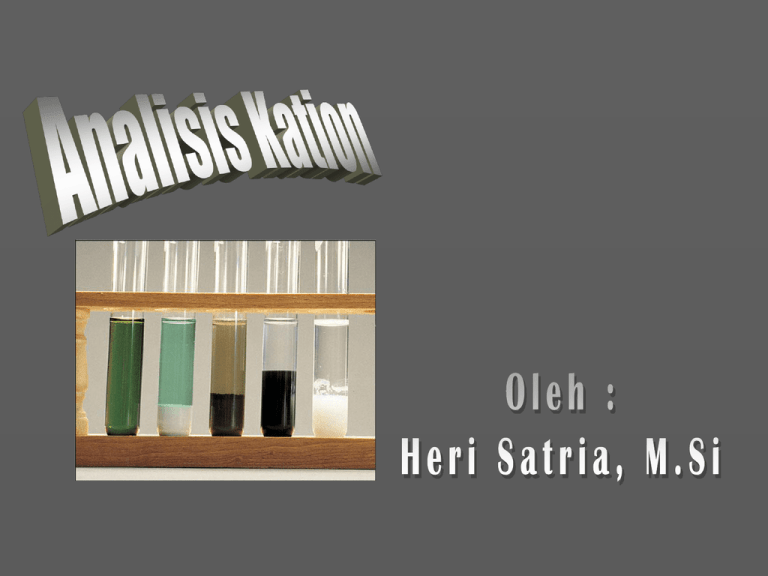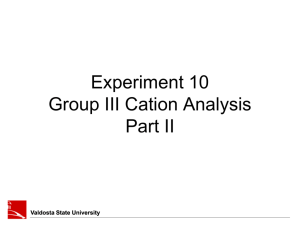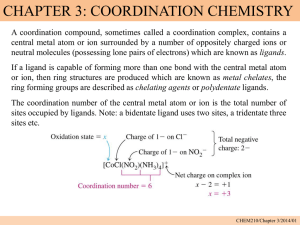Valdosta State University
advertisement

Figure 19.16 The general procedure for separating ions in qualitative analysis 19-2 Add precipitating ion Centrifuge Centrifuge Add precipitating ion Copyright © The McGraw-Hill Companies, Inc. Permission required for reproduction or display. A qualitative analysis scheme for separating cations into five ion groups 19-3 Add (NH4)2HPO4 Copyright © The McGraw-Hill Companies, Inc. Permission required for reproduction or display. Centrifuge Add NH3/NH4+ buffer(pH 8) Centrifuge Centrifuge Centrifuge Add 6M HCl Acidify to pH 0.5; add H2S A qualitative analysis scheme for separating cations into five ion groups 19-4 Add NH3/NH4+ buffer(pH 8) Add (NH4)2HPO4 Copyright © The McGraw-Hill Companies, Inc. Permission required for reproduction or display. Centrifuge Centrifuge Centrifuge Add 6M HCl Acidify to pH 0.5; add H2S Centrifuge Figure 19.17 Using pH and complexation to Separate Ions For Qualitative Analysis 19-5 Hot water AgCl(s); Hg2Cl2(s) Pb2+ CrO42,aqueous ppt 2 Pbaqueous CrO42,aqueous PbCrO4 , solid 19-6 Hot water AgCl(s); Hg2Cl2(s) Pb2+ CrO42,aqueous NH3 HgNH2Cl(s) ppt Ag(NH3)6+ Ag aqueous NH3aqueous AgNH 3aqueous AgNH3aqueous NH3aqueous Ag NH 3 2 aqueous 19-7 Centrifuge Centrifuge Figure 19.18 A qualitative analysis scheme for Ag+,Al3+,Cu2+, and Fe3+ Step 1 Step 2 Add Add HCl NH3(aq) Step 3 Add NaOH Centrifuge Step 4 Add HCl, Na2HPO4 19-8 Step 5 Dissolve in HCl and add KSCN Copyright © The McGraw-Hill Companies, Inc. Permission required for reproduction or display. Background General Unknown HCl Group I Insoluble Metal Chlorides and Ammonia HCl / H2S Group II Acid Insoluble Metal Sulfides NH3 / H2S Group III Alkaline Insoluble Metal Sulfides and Hydroxides Valdosta State University Group IV Soluble Metal Ions Background • For this experiment, the group III ions are Fe3+, Ni2+, Mn2+, Al3+ and Zn2+. • These ions initially precipitate as either metal sulfides (in an alkaline environment) or metal hydroxides. • This requires the chemist to generate a small quantity of sulfide ion to precipitate the metals. • A convenient source of S2- is thioacetamide, which decomposes when heated to give hydrogen sulfide (H2S) which yields S2- in chemical reactions. • A reagent that is made and consumed in the same flask is said to be produced in situ. Valdosta State University Background – Hydrogen Sulfide S H H C C H O N H H + 2 H2O + H H+(aq) H C C H O + NH4+(aq) + H2S(g) H Thioacetamide H2S(aq) + 2 H2O(l) D 2 H3O+(aq) + S2-(aq) • The addition of base to the second reaction consumes the hydronium ion and drives the reaction to the right, increasing the concentration of S2-(aq). Valdosta State University Background – Group III Separation Scheme Group III Unknown NH3, H2S, heat NiS, FeS, MnS, ZnS, Fe(OH)3, Al(OH)3 Group IV ions HCl, HNO3, heat Ni2+, Fe3+, Mn2+, Zn2+, Al3+ Waste 6 M NaOH Fe(OH)3, Ni(OH)2, Mn(OH)2 Al(OH)4-, Zn(OH)42- HNO3 Divide sample HNO3 NaBiO3 NH3 MnO4purple Conc. NH3 Ni(NH3)62 Fe(OH)3 + HCl / NH4SCN H2DMG Fe(SCN)63blood red Ni(DMG)2 strawberry red ppt. Al(OH)3 aluminon, NH3 Al(OH)3aluminon cherry red ppt. Valdosta State University Zn(NH3)42+ K4Fe(CN)6 K2Zn3[Fe(CN)6]2 white ppt. Background – Group III Separation Scheme A – Preparation of Group III cations Group III unknown NH3, H2S, Heat NiS, FeS, MnS, Fe(OH)3, Al(OH)3, ZnS Group IV ions • The group III ions are initially separated from the bulk solution by precipitation as either insoluble metal sulfides or hydroxides. Ni2+(aq) + S2(aq) D NiS(s) (black) Fe2+(aq) + S2(aq) D FeS(s) (black) Zn2+(aq) + S2(aq) D ZnS(s) (white) Mn2+(aq) + S2(aq) D MnS(s) (pink) Al3+(aq) + 3 OH(aq) D Al(OH)3(s) (white, gel) Valdosta State University Background – Group III Separation Scheme A – Preparation of Group III cations Group III unknown NH3, H2S, Heat NiS, FeS, MnS, Fe(OH)3, Al(OH)3, ZnS Group IV ions • Since iron has two common oxidation states, its chemistry in this step is more complex. • If iron(III) is present it is reduced to iron(II) and elemental sulfur in produced. 2 Fe3+(aq) + H2S (aq) 2 Fe2+(aq) + S(s) + 2 H+(aq) Valdosta State University Background – Group III Separation Scheme A – Preparation of Group III cations Group III unknown • Alternately, the iron(III) can combine with the hydroxide ion and precipitate as iron(III) hydroxide. NH3, H2S, Heat NiS, FeS, MnS, Fe(OH)3, Al(OH)3, ZnS Group IV ions Fe3+(aq) + 3 OH-(aq) D Fe(OH)3 (rust color) Valdosta State University Background – Group III Separation Scheme B1 – Separation of Group III cations NiS, FeS, MnS, Fe(OH)3, Al(OH)3 HCl, HNO3, Heat Waste • Following the precipitation, the metal ions are combined with acid to form the free (and soluble) metal ions. Ni2+, Fe3+, Mn2+, Zn2+, Al3+ 3NiS(s) +8H+(aq) + 2NO3(aq) 3Ni2+(aq) + 2NO(g) + 3S(s) + 4H2O(l) FeS(s) + 2 H+ (aq) Fe2+(aq) + H2S(aq) 3Fe2+(aq) + 4H+(aq) + NO3(aq) 3Fe3+(aq) + NO(g) + 2H2O(l) MnS(s) + 2 H+(aq) Mn2+(aq) + H2S(aq) ZnS(s) + 2 H+(aq) Zn2+(aq) + H2S(aq) Al(OH)3(s) + 3 H+(aq) Al3+(aq) + H2O(l) Valdosta State University Background – Group III Separation Scheme B2 – Separation of Group III cations Ni2+, Fe3+, Mn2+, Zn2+, Al3+ 6 M NaOH Fe(OH)3, Ni(OH)2, Mn(OH)2 Al(OH)4-, Zn(OH)42- • Aluminum and zinc ions are amphoteric. • This means that at high acid or base concentrations, these metals form soluble complexes, but precipitate at moderate pH. • Iron, manganese and nickel form insoluble hydroxides at high pH. Fe3+(aq) + 3 OH(aq) D Fe(OH)3(s) (rust-color) Ni2+(aq) + 2 OH(aq) D Ni(OH)2(s) (green) Mn2+(aq) + 2 OH(aq) D Mn(OH)2(s) (light brown) Valdosta State University Background – Group III Separation Scheme B2 – Separation of Group III cations Ni2+, Fe3+, Mn2+, Zn2+, Al3+ 6 M NaOH Fe(OH)3, Ni(OH)2, Mn(OH)2 Al(OH)4-, Zn(OH)42- • Aluminum and zinc ions are amphoteric. • This means that at high acid or base concentrations, these metals form soluble complexes, but precipitate at moderate pH. • Iron, manganese and nickel form insoluble hydroxides at high pH. Al3+(aq) + 3 OH(aq) D Al(OH)3(s) (white, gelatinous) Zn2+(aq) + 2 OH(aq) D Zn(OH)2(s) (white) Valdosta State University Background – Group III Separation Scheme B2 – Separation of Group III cations Ni2+, Fe3+, Mn2+, Zn2+, Al3+ 6 M NaOH Fe(OH)3, Ni(OH)2, Mn(OH)2 Al(OH)4-, Zn(OH)42- Excess Acid Al(OH)3(s) + 3H+(aq) D Al3+ + 3 H2O(aq) Zn(OH)2(s) + 2H+(aq) D Zn2+ + 2 H2O(aq) Valdosta State University Background – Group III Separation Scheme B2 – Separation of Group III cations Ni2+, Fe3+, Mn2+, Zn2+, Al3+ 6 M NaOH Fe(OH)3, Ni(OH)2, Mn(OH)2 Al(OH)4-, Zn(OH)42- Excess Base Al(OH)3(s) + OH(aq) D Al(OH)4-(aq) Zn(OH)2(s) + 2OH(aq) D Zn(OH)42-(aq) Valdosta State University Background – Group III Separation Scheme Fe(OH)3, Ni(OH)2, Mn(OH)2 HNO3, KNO2 Fe3+, Ni2+, Mn2+ Divide Sample Valdosta State University C1 – Test for Mn2+, Fe3+, Ni2+ • The precipitate is redissolved by adding acid to the precipitate. • The addition of nitric acid neutralizes the sodium hydroxide and regenerates the free cations. • There is no easy method which will allow Mn2+, Fe3+ and Ni2+ to be separated; therefore, the sample is divided. Background – Group III Separation Scheme C2 – Test for Mn2+ Fe3+, Ni2+, Mn2+ Divide Sample NaBiO3 • If sodium bismuthate is added to a solution containing manganese(II), a redox reaction occurs resulting in the formation of the purple permanganate ion. MnO4purple 14H+(aq) + 2Mn2+(aq) + 5BiO3-(s) 2 MnO4-(aq) + 5Bi3+(aq) + 7H2O(l) Valdosta State University Background – Group III Separation Scheme D1 – Separation of Fe3+ and Ni2+ Fe3+, Ni2+, Mn2+ Divide Sample Conc. NH3 Fe(OH)3 Ni(NH3)62+ • The nickel and iron ions can be separated by the addition of ammonia. • The increased pH causes the formation of the insoluble iron(III) hydroxide. • The nickel ion combines with ammonia to form a soluble complex ion, hexaamminenickel(II). Fe3+(aq) + 3NH3(aq) + 3H2O(l) 3NH4+(aq) + Fe(OH)3(s) (brown) Ni2+(aq) + 6NH3(aq) D Ni(NH3)62+(aq) (blue) Valdosta State University Background – Group III Separation Scheme D2 – Test for Fe3+ Fe3+, Ni2+, Mn2+ • The presence of the iron(III) ion is confirmed by the addition of ammonium thiocyanate. • If iron(III) is present, a blood red solution forms. Divide Sample Conc. NH3 Fe(OH)3 Ni(NH3)62+ HCl / NH4SCN Fe(SCN)63blood red Fe3+(aq) + 6SCN-(aq) D Fe(SCN)63-(aq) blood red Valdosta State University Background – Group III Separation Scheme E – Test for Ni2+ Fe3+, Ni2+, Mn2+ • The presence of the nickel ion is confirmed by the addition of dimethylglyoxime. • Dimethylglyoxime combines with the nickel ion to form a complex which forms a strawberry red precipiate. Divide Sample Conc. NH3 Ni(NH3)62+ Fe(OH)3 HCl / NH4SCN H2DMG Fe(SCN)63blood red Ni(DMG)2 strawberry red ppt. Ni(NH3)62+(aq) + 2 HC4H7N2O2(aq) 4NH3(aq) + 2NH4+(aq) + Ni(C4H7N2O2)2(s) (red) Valdosta State University Background – Group III Separation Scheme Al(OH)4-, Zn(OH)42- HNO3 NH3 Al(OH)3 Zn(NH3)42+ F1 – Separation of Al3+ and Zn2+ • Careful control of pH allows for the separation of aluminum and zinc ions. • The solution is made very slightly basic. • At these conditions, the aluminum ion precipitates as aluminum hydroxide. • The zinc ion remains in solution. Al3+(aq) + 3 NH3(aq) + 3 H2O(l) D 3 NH4+(aq) + Al(OH)3(s) Zn2+(aq) + 4 NH3(aq) D Zn(NH3)42+(aq) Valdosta State University Background – Group III Separation Scheme Al(OH)4-, Zn(OH)42- NH3 HNO3 Al(OH)3 Zn(NH3)42+ NH3, aluminon F2 – Test for Al3+ • A successful test for aluminum requires that the previous reactions and their pH control were properly performed. • If not, false positive tests result. • The test for aluminum requires the free aluminum ion to react with ammonia in the presence of a reagent called aluminon and form a red precipitate. • Be careful, if there is iron or zinc left in the sample, a red precipitate will form resulting in a false positive. Al(OH)3 aluminon cherry red ppt. Al3+(aq) + 3 NH3(aq) + 3 H2O + aluminon(aq) D 3 NH4+(aq) + Al(OH)3aluminon(s) (red) Valdosta State University Background – Group III Separation Scheme F2 – Test for Al3+ Al(OH)4-, Zn(OH)42- • To confirm that the red precipitate is the aluminum complex, ammonium carbonate is added. • If the red color does not fade, aluminum is present. NH3 HNO3 Al(OH)3 Zn(NH3)42+ NH3, aluminon Al(OH)3 aluminon cherry red ppt. Valdosta State University Background – Group III Separation Scheme G – Test for Zn2+ Al(OH)4-, Zn(OH)42- NH3 HNO3 Zn(NH3)42+ Al(OH)3 NH3, aluminon K4Fe(CN)6 Al(OH)3 aluminon cherry red ppt. • To test for the zinc ion, a solution of potassium hexacyanoferrate(II) is added to the test solution. • If zinc is present a white precipitate forms. • The exact color of the precipitate can vary depending on the presence of other ions. • If iron is present the color can change to yellow, green or blue. K2Zn3[Fe(CN)6]2 white ppt. 3 Zn2+(aq) + 2 K+(aq) + 2 Fe(CN)64 (aq) D K2Zn3[Fe(CN)6]2 (s) Valdosta State University Background – Group III Separation Scheme Zn2+ Al3+ Valdosta State University Ni2+ Fe3+ Mn2+ Background Group IV Unknown Flame Test K+ lavender flame Flame Test Na+ orange-yellow flame HC2H3O2, K2CrO4 BaCrO4 yellow ppt. 6M HCl Ba2+ Flame Test apple - green 6M H2SO4 (NH4)2C2O4 BaSO4 white ppt. CaC2O4 white ppt. Mg2+ NH3(aq), NaH2PO4, heat 6M HCl Flame Test red-orange Valdosta State University Ca2+, Mg2+ MgNH4PO46H2O white ppt. Background – Group IV Separation Scheme A – Flame test for Na+ and K+ Group IV Unknown Flame Test K+ lavender flame Flame Test Na+ orange-yellow flame Na Valdosta State University • Insoluble salts of sodium and potassium are not known. • One method of determining the presence of these ions is the flame test. K Background – Group IV Separation Scheme B – Test for Ba2+ HC2H3O2, K2CrO4 • The formation of a yellow precipitate on the addition of potassium chromate indicates the presence of the barium ion. BaCrO4 yellow ppt. 6M HCl Ba2+ Flame Test apple - green 6M H2SO4 BaSO4 white ppt. Valdosta State University Ba2+(aq) + K2CrO4(aq) BaCrO4(s) + 2K+(aq) Background – Group IV Separation Scheme B – Test for Ba2+ HC2H3O2, K2CrO4 • A flame test (apple green) is used to confirm the presence of the ion. BaCrO4 yellow ppt. 6M HCl Ba2+ Flame Test apple - green 6M H2SO4 BaSO4 white ppt. Valdosta State University Background – Group IV Separation Scheme B – Test for Ba2+ HC2H3O2, K2CrO4 • The final test for barium is the formation of a white precipitate on the addition of a sulfate to the solution. BaCrO4 yellow ppt. 6M HCl Ba2+ Flame Test apple - green 6M H2SO4 BaSO4 white ppt. Valdosta State University Ba2+(aq) + H2SO4(aq) BaSO4(s) + 2H+(aq) Background – Group IV Separation Scheme Ca2+, C – Test for Ca2+ Mg2+ • The calcium ion is separated from magnesium by precipitating calcium oxalate. (NH4)2C2O4 CaC2O4 6M HCl Flame test red-orange Valdosta State University Mg2+ Ca2+(aq) + (NH4)2C2O4(aq) CaC2O4(s) + 2NH4+(aq) Background – Group IV Separation Scheme Ca2+, C – Test for Ca2+ Mg2+ • A flame test (red-orange flame) is used to confirm the presence of the calcium ion. (NH4)2C2O4 CaC2O4 6M HCl Flame test red-orange Valdosta State University Mg2+ Background – Group IV Separation Scheme Ca2+, C – Test for Mg2+ Mg2+ • The magnesium ion is precipitated as a white solid (ammonium phosphate) in an alkaline solution. K2C2O4 Mg2+ CaC2O4 Mg2+(aq) + NH3(aq) + HPO42-(aq) MgNH4PO4(s) NH3(aq) Na2HPO4(aq) 6M HCl Flame test red-orange MgNH4PO46H2O white ppt. Valdosta State University Sample Problem 19.12 Separating Ions by Selective Precipitation PROBLEM: A solution consists of 0.20M MgCl2 and 0.10M CuCl2. Calculate the [OH-] that would separate the metal ions as their hydroxides. Ksp of Mg(OH)2= is 6.3x10-10; Ksp of Cu(OH)2 is 2.2x10-20. PLAN: Both precipitates are of the same ion ratio, 1:2, so we can compare their Ksp values to determine which has the greater solubility. It is obvious that Cu(OH)2 will precipitate first so we calculate the [OH-] needed for a saturated solution of Mg(OH)2. This should ensure that we do not precipitate Mg(OH)2. Then we can check how much Cu2+ remains in solution. SOLUTION: Mg(OH)2(s) Mg2+(aq) + 2OH-(aq) Ksp = 6.3x10-10 Cu(OH)2(s) Cu2+(aq) + 2OH-(aq) [OH-] needed for a saturated Mg(OH)2 solution = = 5.6x10-5M Ksp = 2.2x10-20 K sp [Mg2 ] 6.3x1010 0.20









